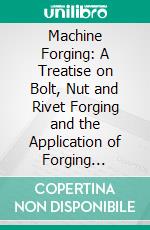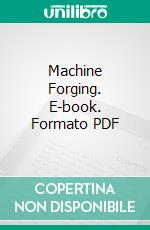Douglas T Hamilton eBooks
eBooks di Douglas T Hamilton
Automatic Screw Machine Practice: Circular Form and Cut-Off Tools for the Brown and Sharpe Automatic Screw Machine. E-book. Formato PDF Douglas T. Hamilton - Forgotten Books, 2017 -
When any given piece or work is to be made on the screw machine, the methods of arranging the operations and the tools to be used should be decided upon before designing the cams. One of the first things to consider is the method of applying the circular form and cut oif tools. The methods, or course, will vary to a considerable extent, according to the shape of the piece to be made.
Machine Forging: A Treatise on Bolt, Nut and Rivet Forging and the Application of Forging Machines to Forming, Welding and Upsetting Operations on Machine Parts. E-book. Formato PDF Douglas Thomas Hamilton - Forgotten Books, 2017 -
The bolt and nut industry in America started in a very small way in Marion, Conn., in 1818. In that year Micah Rugg, a country blacksmith, made bolts by the forging process. The first machine used for this purpose was a device known as a heading block, which was operated by a foot treadle and a connecting lever. The connecting lever held the blank while it was being driven down into the impression in the heading block by a hammer. The square iron from which the bolt was made was first rounded, so that it could be admitted into the block. At first Rugg made bolts only to order, and charged at the rate of sixteen cents apiece. This industry developed very slowly until 1839, when Rugg went into partnership with Martin Barnes; 'together they built the first exclusive bolt and nut factory in the United States in Marion, Conn. The bolt and nut industry was started in England in 1838 by Thomas Oliver, of Darlston, Staffordshire. His machine was built on a somewhat different plan from that of Rugg's, but no doubt was a further development of the first machine; Oliver's machine was known as the English Oliver.
Machine Forging. E-book. Formato PDF Douglas T. Hamilton - Forgotten Books, 2017 -
The upsetting and forging machine might be considered to a certain extent as a further development of the bolt and rivet making machine, which was originated almost a century ago; but forging machines are built much heavier than bolt and rivet machines and are designed especially to meet the demands in the production of difficult-shaped and heavy forgings. For the heavier types of machines, the base or main frame, as a rule, is made from one solid steel casting. A typical upsetting and forging machine designed for heavy service is shown in Fig. 1. The bed of this machine is made from one solid casting of semi-steel. In order to provide against breakage caused by accidentally placing work between the dies, upsetting and forging ma chines are usually furnished with various safety devices to prevent serious damage to the machine. The safety device in this machine consists of a toggle-joint mechanism for operating the movable grip ping-die slide. The gripping die slide A, Fig. 1, is operated by two cams B and C' on the main crankshaft D. Cam B serves to close the dies which grip the work; cam C operates the opening mechanism for the dies. These cams are in contact with chilled cast-iron rolls E and F carried in the toggle slide G. The automatic grip relief is controlled by the by-pass toggle H and heavy coil spring I. This toggle does not come into play until the strain is such that it would cause damage to the working mechanism of the machine, or in other words until the maximum power required to hold the movable die from springing away,' is attained. The relief resets automatically on the back stroke of the machine, thus making a second blow possible without delay.


